Business Finance: Investment Appraisal, NPV & Funding for K PLC
VerifiedAdded on 2023/06/16
|19
|3950
|285
Report
AI Summary
This report provides a comprehensive analysis of business finance principles, focusing on project evaluation techniques and capital raising strategies. It begins with an evaluation of several projects using discounted payback period and net present value (NPV) methods, ranking them based on these metrics. The report discusses the strengths and weaknesses of both payback period and NPV, along with qualitative factors influencing investment decisions. Furthermore, it explores alternative external sources of capital, including debt capital, trade credit, and factoring, linking investment choices to financial decisions. The report includes a variance analysis statement of variable costs, identifying areas where resource utilization can be improved. This document, contributed by a student and available on Desklib, offers valuable insights for students studying finance.

Business Finance
1
1
Paraphrase This Document
Need a fresh take? Get an instant paraphrase of this document with our AI Paraphraser
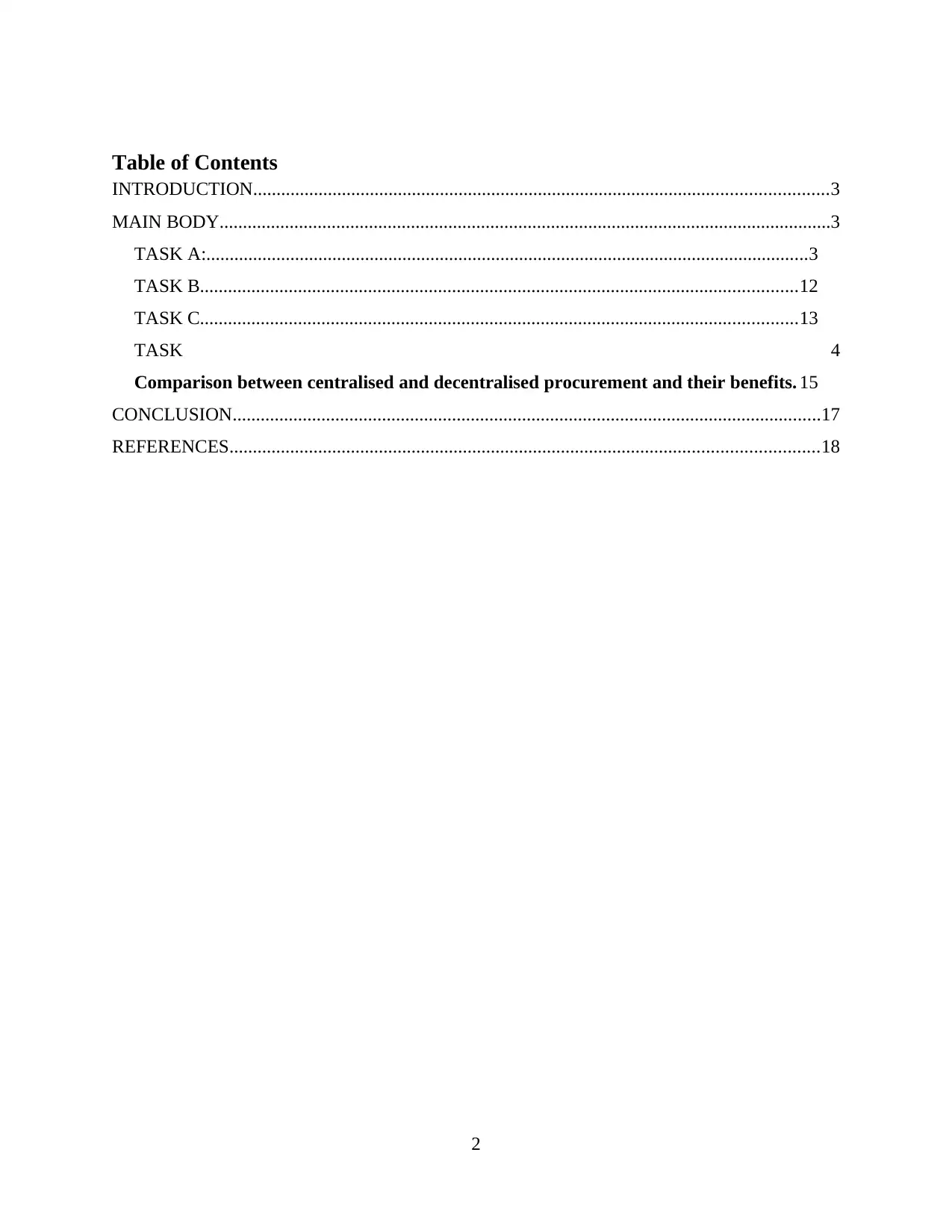
Table of Contents
INTRODUCTION...........................................................................................................................3
MAIN BODY...................................................................................................................................3
TASK A:.................................................................................................................................3
TASK B................................................................................................................................12
TASK C................................................................................................................................13
TASK 4
Comparison between centralised and decentralised procurement and their benefits. 15
CONCLUSION..............................................................................................................................17
REFERENCES..............................................................................................................................18
2
INTRODUCTION...........................................................................................................................3
MAIN BODY...................................................................................................................................3
TASK A:.................................................................................................................................3
TASK B................................................................................................................................12
TASK C................................................................................................................................13
TASK 4
Comparison between centralised and decentralised procurement and their benefits. 15
CONCLUSION..............................................................................................................................17
REFERENCES..............................................................................................................................18
2
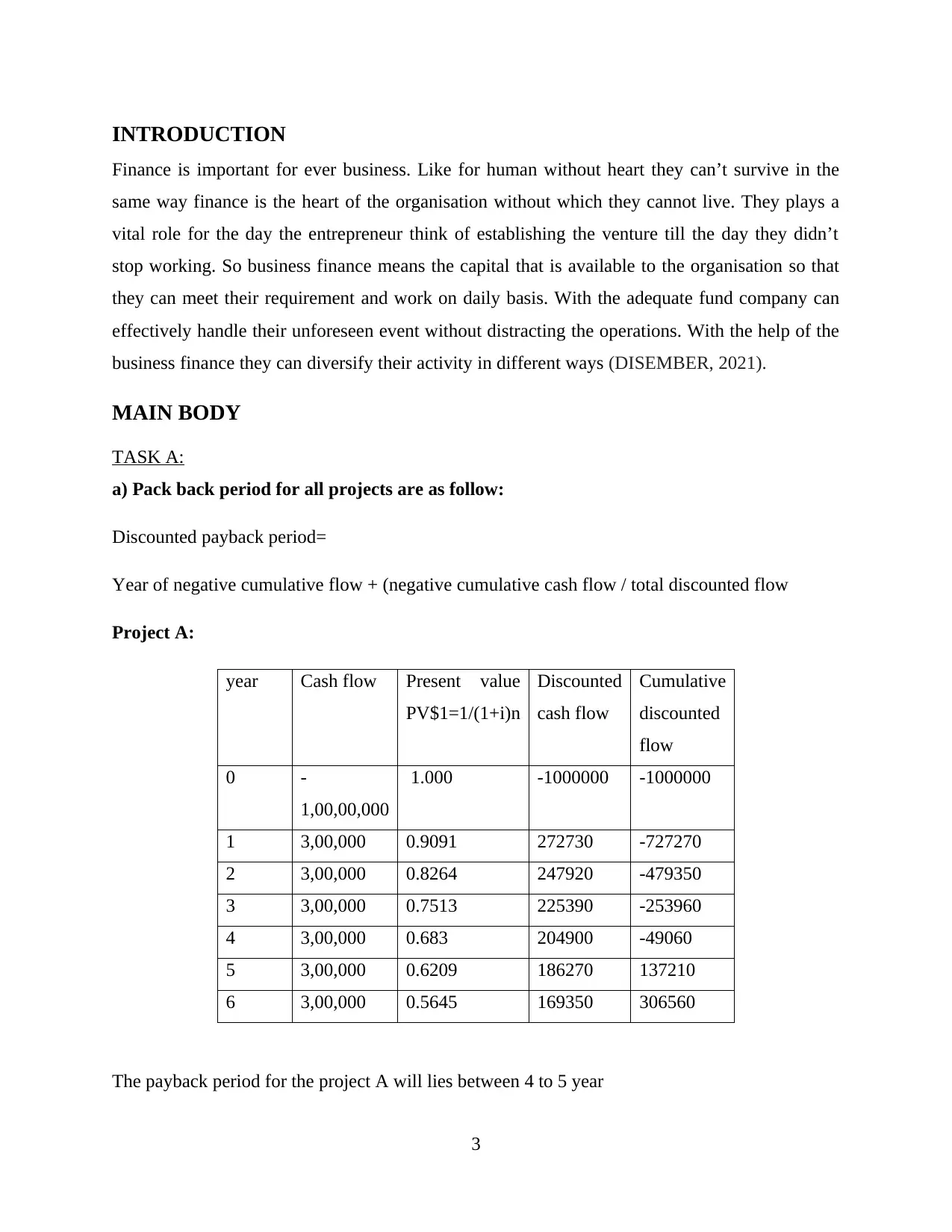
INTRODUCTION
Finance is important for ever business. Like for human without heart they can’t survive in the
same way finance is the heart of the organisation without which they cannot live. They plays a
vital role for the day the entrepreneur think of establishing the venture till the day they didn’t
stop working. So business finance means the capital that is available to the organisation so that
they can meet their requirement and work on daily basis. With the adequate fund company can
effectively handle their unforeseen event without distracting the operations. With the help of the
business finance they can diversify their activity in different ways (DISEMBER, 2021).
MAIN BODY
TASK A:
a) Pack back period for all projects are as follow:
Discounted payback period=
Year of negative cumulative flow + (negative cumulative cash flow / total discounted flow
Project A:
year Cash flow Present value
PV$1=1/(1+i)n
Discounted
cash flow
Cumulative
discounted
flow
0 -
1,00,00,000
1.000 -1000000 -1000000
1 3,00,000 0.9091 272730 -727270
2 3,00,000 0.8264 247920 -479350
3 3,00,000 0.7513 225390 -253960
4 3,00,000 0.683 204900 -49060
5 3,00,000 0.6209 186270 137210
6 3,00,000 0.5645 169350 306560
The payback period for the project A will lies between 4 to 5 year
3
Finance is important for ever business. Like for human without heart they can’t survive in the
same way finance is the heart of the organisation without which they cannot live. They plays a
vital role for the day the entrepreneur think of establishing the venture till the day they didn’t
stop working. So business finance means the capital that is available to the organisation so that
they can meet their requirement and work on daily basis. With the adequate fund company can
effectively handle their unforeseen event without distracting the operations. With the help of the
business finance they can diversify their activity in different ways (DISEMBER, 2021).
MAIN BODY
TASK A:
a) Pack back period for all projects are as follow:
Discounted payback period=
Year of negative cumulative flow + (negative cumulative cash flow / total discounted flow
Project A:
year Cash flow Present value
PV$1=1/(1+i)n
Discounted
cash flow
Cumulative
discounted
flow
0 -
1,00,00,000
1.000 -1000000 -1000000
1 3,00,000 0.9091 272730 -727270
2 3,00,000 0.8264 247920 -479350
3 3,00,000 0.7513 225390 -253960
4 3,00,000 0.683 204900 -49060
5 3,00,000 0.6209 186270 137210
6 3,00,000 0.5645 169350 306560
The payback period for the project A will lies between 4 to 5 year
3
⊘ This is a preview!⊘
Do you want full access?
Subscribe today to unlock all pages.

Trusted by 1+ million students worldwide
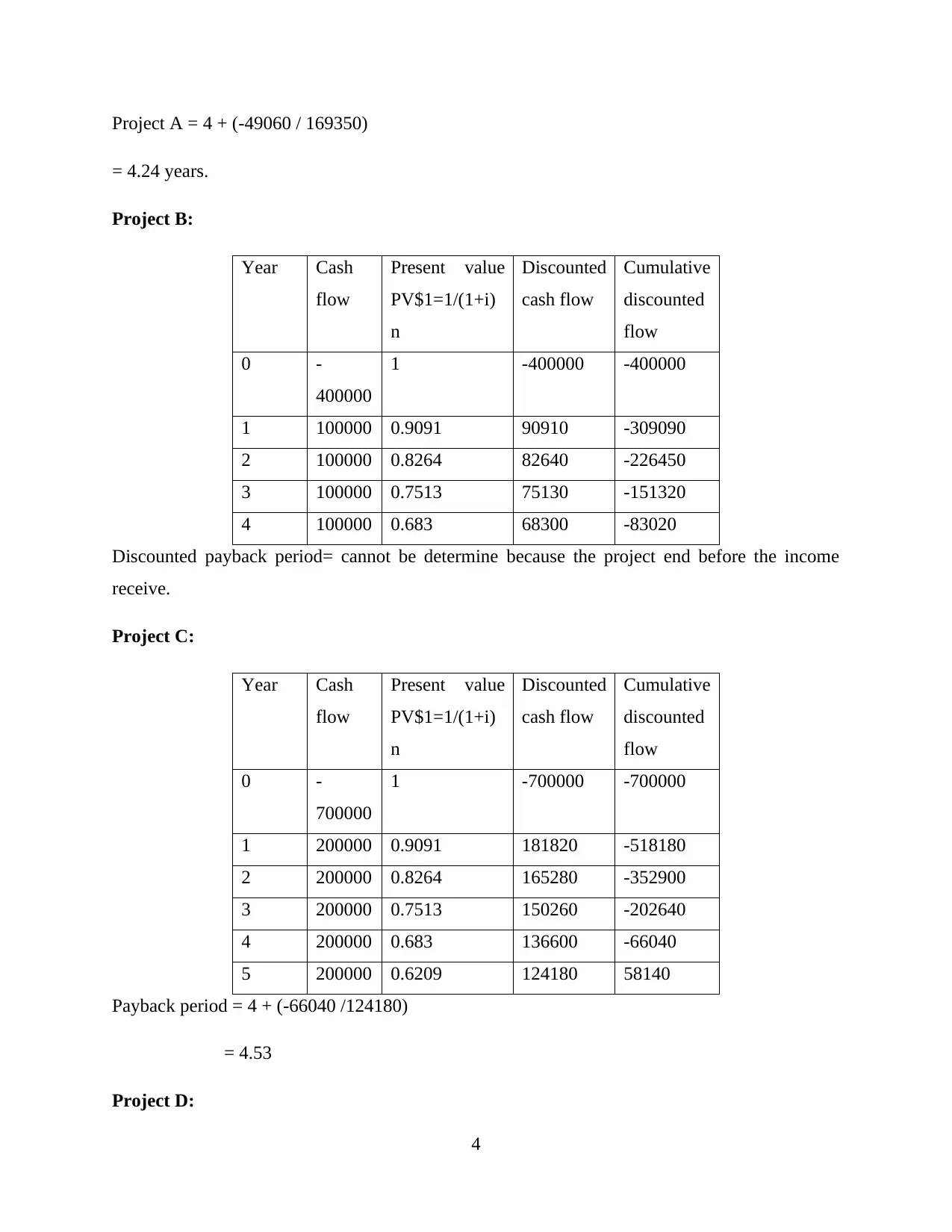
Project A = 4 + (-49060 / 169350)
= 4.24 years.
Project B:
Year Cash
flow
Present value
PV$1=1/(1+i)
n
Discounted
cash flow
Cumulative
discounted
flow
0 -
400000
1 -400000 -400000
1 100000 0.9091 90910 -309090
2 100000 0.8264 82640 -226450
3 100000 0.7513 75130 -151320
4 100000 0.683 68300 -83020
Discounted payback period= cannot be determine because the project end before the income
receive.
Project C:
Year Cash
flow
Present value
PV$1=1/(1+i)
n
Discounted
cash flow
Cumulative
discounted
flow
0 -
700000
1 -700000 -700000
1 200000 0.9091 181820 -518180
2 200000 0.8264 165280 -352900
3 200000 0.7513 150260 -202640
4 200000 0.683 136600 -66040
5 200000 0.6209 124180 58140
Payback period = 4 + (-66040 /124180)
= 4.53
Project D:
4
= 4.24 years.
Project B:
Year Cash
flow
Present value
PV$1=1/(1+i)
n
Discounted
cash flow
Cumulative
discounted
flow
0 -
400000
1 -400000 -400000
1 100000 0.9091 90910 -309090
2 100000 0.8264 82640 -226450
3 100000 0.7513 75130 -151320
4 100000 0.683 68300 -83020
Discounted payback period= cannot be determine because the project end before the income
receive.
Project C:
Year Cash
flow
Present value
PV$1=1/(1+i)
n
Discounted
cash flow
Cumulative
discounted
flow
0 -
700000
1 -700000 -700000
1 200000 0.9091 181820 -518180
2 200000 0.8264 165280 -352900
3 200000 0.7513 150260 -202640
4 200000 0.683 136600 -66040
5 200000 0.6209 124180 58140
Payback period = 4 + (-66040 /124180)
= 4.53
Project D:
4
Paraphrase This Document
Need a fresh take? Get an instant paraphrase of this document with our AI Paraphraser
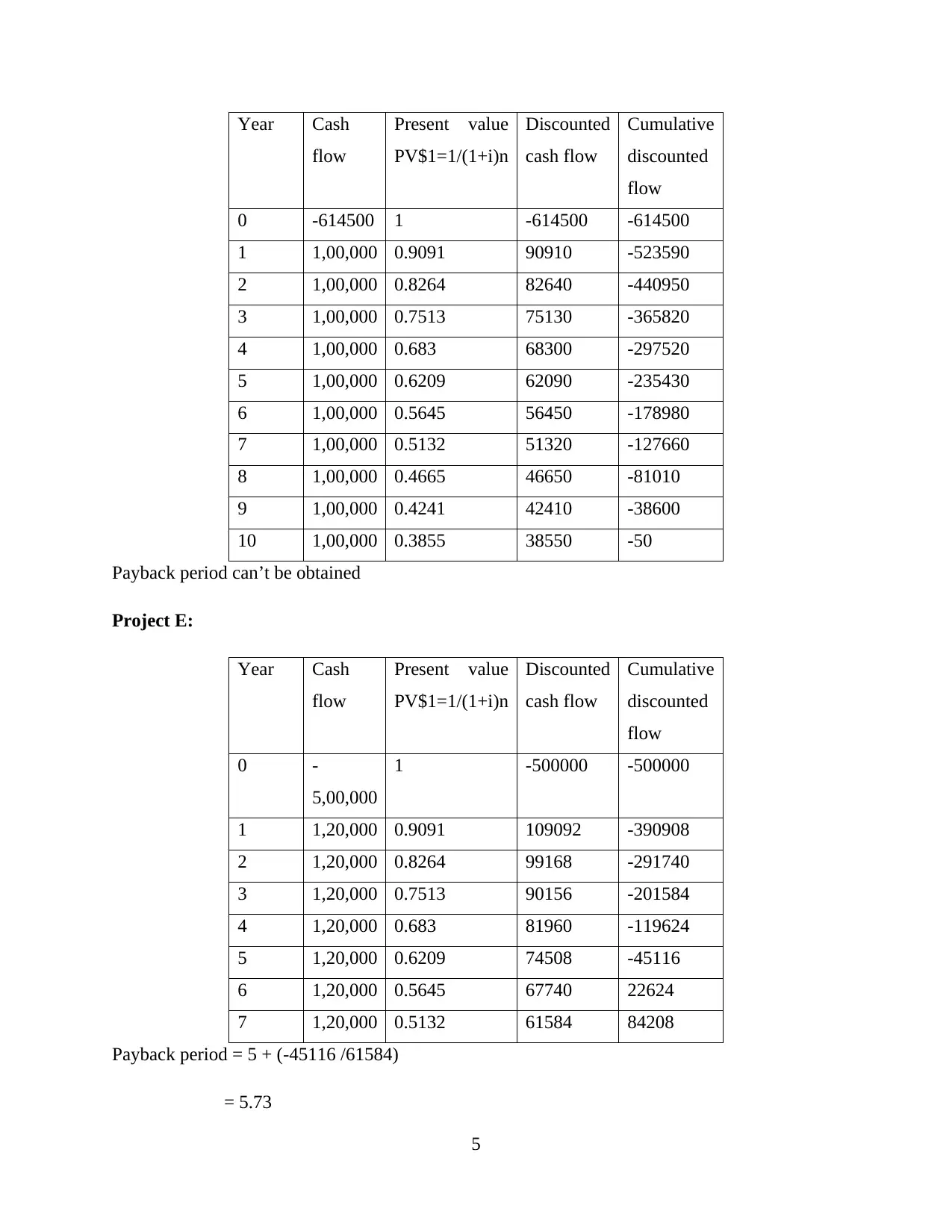
Year Cash
flow
Present value
PV$1=1/(1+i)n
Discounted
cash flow
Cumulative
discounted
flow
0 -614500 1 -614500 -614500
1 1,00,000 0.9091 90910 -523590
2 1,00,000 0.8264 82640 -440950
3 1,00,000 0.7513 75130 -365820
4 1,00,000 0.683 68300 -297520
5 1,00,000 0.6209 62090 -235430
6 1,00,000 0.5645 56450 -178980
7 1,00,000 0.5132 51320 -127660
8 1,00,000 0.4665 46650 -81010
9 1,00,000 0.4241 42410 -38600
10 1,00,000 0.3855 38550 -50
Payback period can’t be obtained
Project E:
Year Cash
flow
Present value
PV$1=1/(1+i)n
Discounted
cash flow
Cumulative
discounted
flow
0 -
5,00,000
1 -500000 -500000
1 1,20,000 0.9091 109092 -390908
2 1,20,000 0.8264 99168 -291740
3 1,20,000 0.7513 90156 -201584
4 1,20,000 0.683 81960 -119624
5 1,20,000 0.6209 74508 -45116
6 1,20,000 0.5645 67740 22624
7 1,20,000 0.5132 61584 84208
Payback period = 5 + (-45116 /61584)
= 5.73
5
flow
Present value
PV$1=1/(1+i)n
Discounted
cash flow
Cumulative
discounted
flow
0 -614500 1 -614500 -614500
1 1,00,000 0.9091 90910 -523590
2 1,00,000 0.8264 82640 -440950
3 1,00,000 0.7513 75130 -365820
4 1,00,000 0.683 68300 -297520
5 1,00,000 0.6209 62090 -235430
6 1,00,000 0.5645 56450 -178980
7 1,00,000 0.5132 51320 -127660
8 1,00,000 0.4665 46650 -81010
9 1,00,000 0.4241 42410 -38600
10 1,00,000 0.3855 38550 -50
Payback period can’t be obtained
Project E:
Year Cash
flow
Present value
PV$1=1/(1+i)n
Discounted
cash flow
Cumulative
discounted
flow
0 -
5,00,000
1 -500000 -500000
1 1,20,000 0.9091 109092 -390908
2 1,20,000 0.8264 99168 -291740
3 1,20,000 0.7513 90156 -201584
4 1,20,000 0.683 81960 -119624
5 1,20,000 0.6209 74508 -45116
6 1,20,000 0.5645 67740 22624
7 1,20,000 0.5132 61584 84208
Payback period = 5 + (-45116 /61584)
= 5.73
5
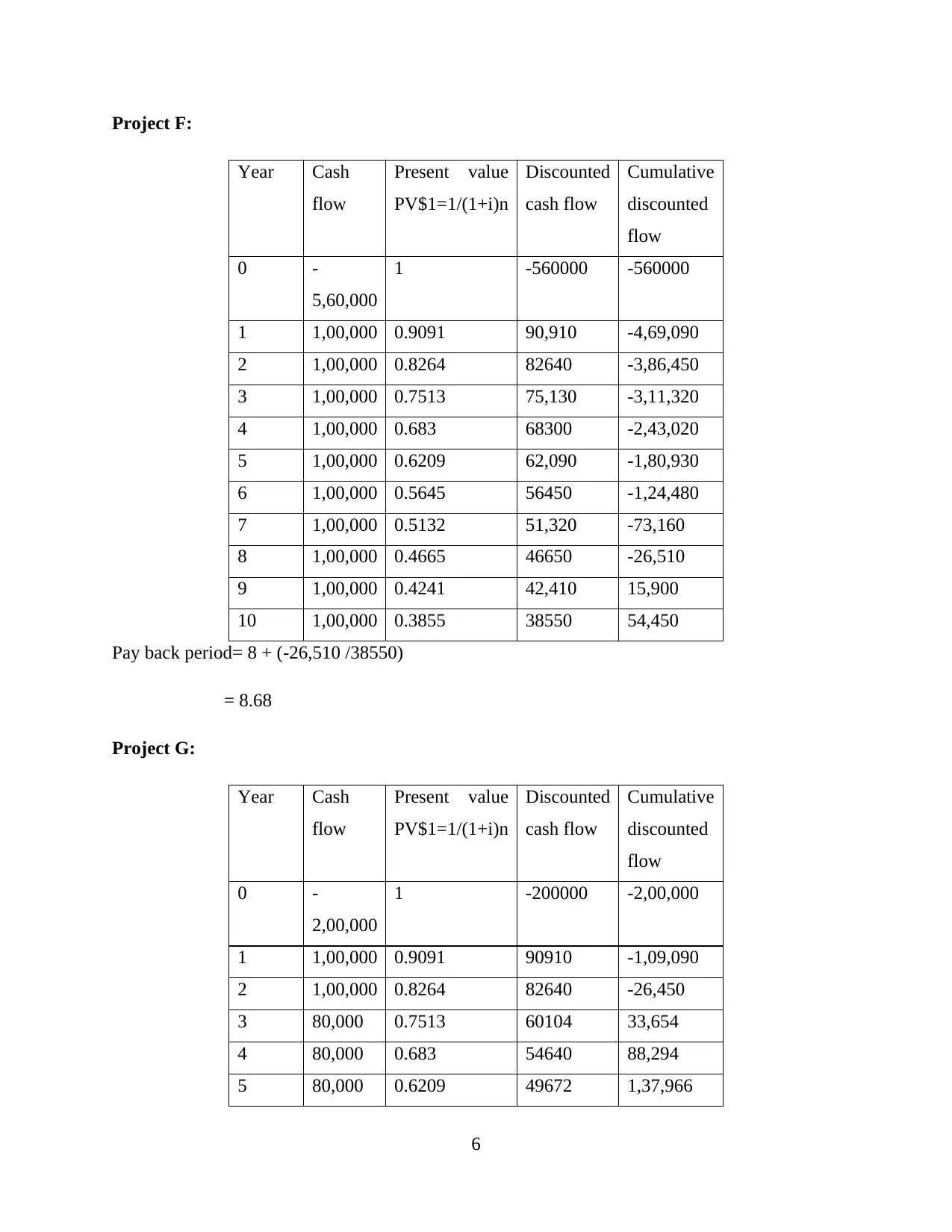
Project F:
Year Cash
flow
Present value
PV$1=1/(1+i)n
Discounted
cash flow
Cumulative
discounted
flow
0 -
5,60,000
1 -560000 -560000
1 1,00,000 0.9091 90,910 -4,69,090
2 1,00,000 0.8264 82640 -3,86,450
3 1,00,000 0.7513 75,130 -3,11,320
4 1,00,000 0.683 68300 -2,43,020
5 1,00,000 0.6209 62,090 -1,80,930
6 1,00,000 0.5645 56450 -1,24,480
7 1,00,000 0.5132 51,320 -73,160
8 1,00,000 0.4665 46650 -26,510
9 1,00,000 0.4241 42,410 15,900
10 1,00,000 0.3855 38550 54,450
Pay back period= 8 + (-26,510 /38550)
= 8.68
Project G:
Year Cash
flow
Present value
PV$1=1/(1+i)n
Discounted
cash flow
Cumulative
discounted
flow
0 -
2,00,000
1 -200000 -2,00,000
1 1,00,000 0.9091 90910 -1,09,090
2 1,00,000 0.8264 82640 -26,450
3 80,000 0.7513 60104 33,654
4 80,000 0.683 54640 88,294
5 80,000 0.6209 49672 1,37,966
6
Year Cash
flow
Present value
PV$1=1/(1+i)n
Discounted
cash flow
Cumulative
discounted
flow
0 -
5,60,000
1 -560000 -560000
1 1,00,000 0.9091 90,910 -4,69,090
2 1,00,000 0.8264 82640 -3,86,450
3 1,00,000 0.7513 75,130 -3,11,320
4 1,00,000 0.683 68300 -2,43,020
5 1,00,000 0.6209 62,090 -1,80,930
6 1,00,000 0.5645 56450 -1,24,480
7 1,00,000 0.5132 51,320 -73,160
8 1,00,000 0.4665 46650 -26,510
9 1,00,000 0.4241 42,410 15,900
10 1,00,000 0.3855 38550 54,450
Pay back period= 8 + (-26,510 /38550)
= 8.68
Project G:
Year Cash
flow
Present value
PV$1=1/(1+i)n
Discounted
cash flow
Cumulative
discounted
flow
0 -
2,00,000
1 -200000 -2,00,000
1 1,00,000 0.9091 90910 -1,09,090
2 1,00,000 0.8264 82640 -26,450
3 80,000 0.7513 60104 33,654
4 80,000 0.683 54640 88,294
5 80,000 0.6209 49672 1,37,966
6
⊘ This is a preview!⊘
Do you want full access?
Subscribe today to unlock all pages.

Trusted by 1+ million students worldwide
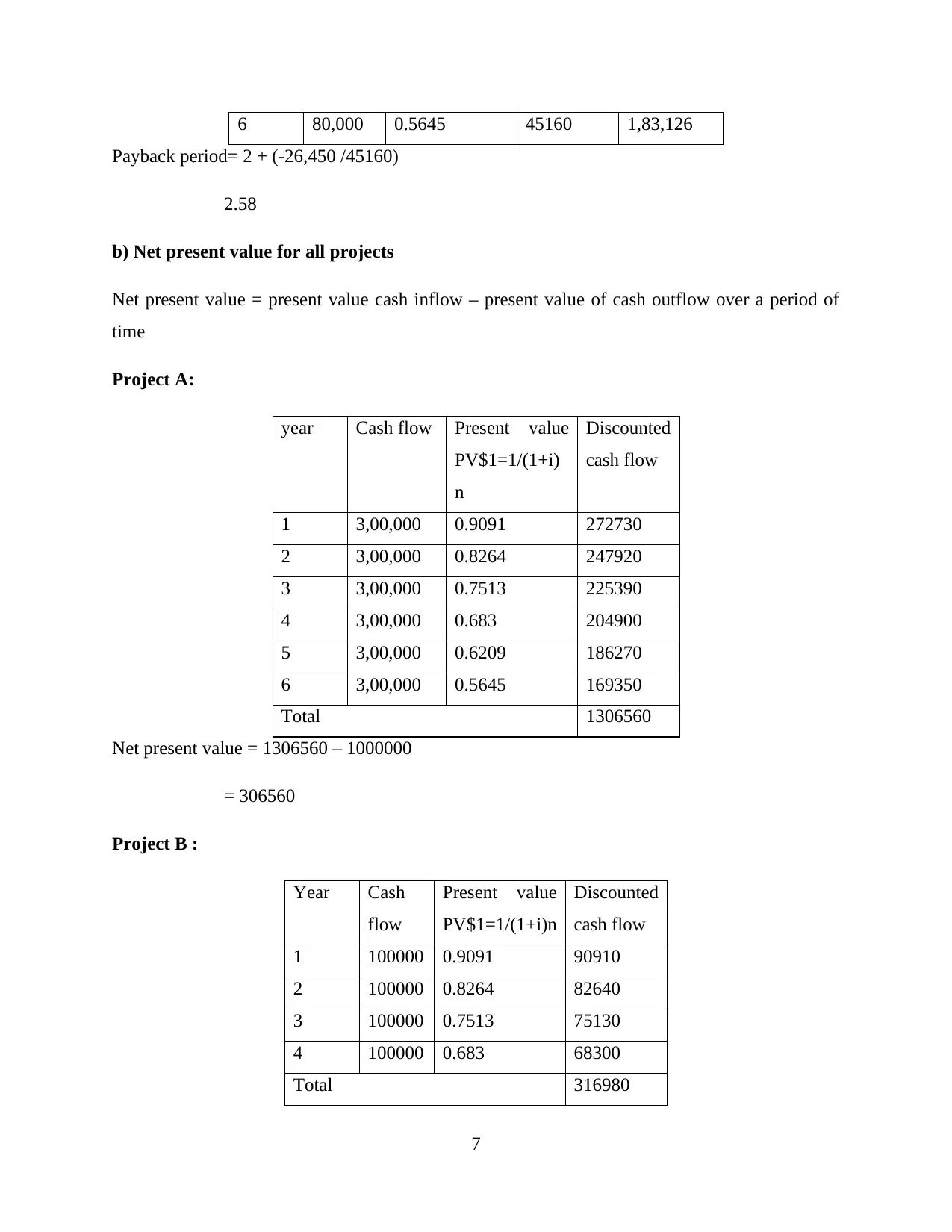
6 80,000 0.5645 45160 1,83,126
Payback period= 2 + (-26,450 /45160)
2.58
b) Net present value for all projects
Net present value = present value cash inflow – present value of cash outflow over a period of
time
Project A:
year Cash flow Present value
PV$1=1/(1+i)
n
Discounted
cash flow
1 3,00,000 0.9091 272730
2 3,00,000 0.8264 247920
3 3,00,000 0.7513 225390
4 3,00,000 0.683 204900
5 3,00,000 0.6209 186270
6 3,00,000 0.5645 169350
Total 1306560
Net present value = 1306560 – 1000000
= 306560
Project B :
Year Cash
flow
Present value
PV$1=1/(1+i)n
Discounted
cash flow
1 100000 0.9091 90910
2 100000 0.8264 82640
3 100000 0.7513 75130
4 100000 0.683 68300
Total 316980
7
Payback period= 2 + (-26,450 /45160)
2.58
b) Net present value for all projects
Net present value = present value cash inflow – present value of cash outflow over a period of
time
Project A:
year Cash flow Present value
PV$1=1/(1+i)
n
Discounted
cash flow
1 3,00,000 0.9091 272730
2 3,00,000 0.8264 247920
3 3,00,000 0.7513 225390
4 3,00,000 0.683 204900
5 3,00,000 0.6209 186270
6 3,00,000 0.5645 169350
Total 1306560
Net present value = 1306560 – 1000000
= 306560
Project B :
Year Cash
flow
Present value
PV$1=1/(1+i)n
Discounted
cash flow
1 100000 0.9091 90910
2 100000 0.8264 82640
3 100000 0.7513 75130
4 100000 0.683 68300
Total 316980
7
Paraphrase This Document
Need a fresh take? Get an instant paraphrase of this document with our AI Paraphraser
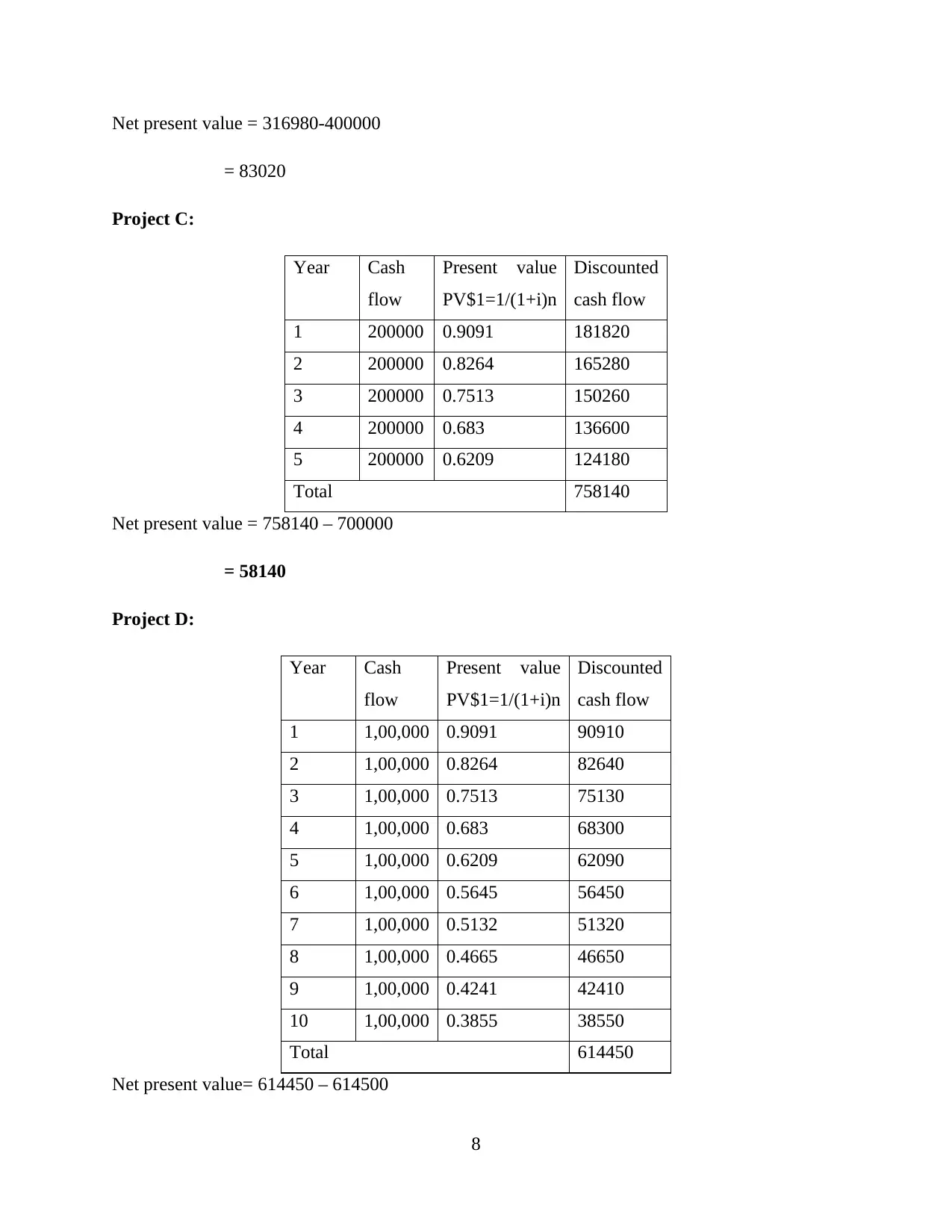
Net present value = 316980-400000
= 83020
Project C:
Year Cash
flow
Present value
PV$1=1/(1+i)n
Discounted
cash flow
1 200000 0.9091 181820
2 200000 0.8264 165280
3 200000 0.7513 150260
4 200000 0.683 136600
5 200000 0.6209 124180
Total 758140
Net present value = 758140 – 700000
= 58140
Project D:
Year Cash
flow
Present value
PV$1=1/(1+i)n
Discounted
cash flow
1 1,00,000 0.9091 90910
2 1,00,000 0.8264 82640
3 1,00,000 0.7513 75130
4 1,00,000 0.683 68300
5 1,00,000 0.6209 62090
6 1,00,000 0.5645 56450
7 1,00,000 0.5132 51320
8 1,00,000 0.4665 46650
9 1,00,000 0.4241 42410
10 1,00,000 0.3855 38550
Total 614450
Net present value= 614450 – 614500
8
= 83020
Project C:
Year Cash
flow
Present value
PV$1=1/(1+i)n
Discounted
cash flow
1 200000 0.9091 181820
2 200000 0.8264 165280
3 200000 0.7513 150260
4 200000 0.683 136600
5 200000 0.6209 124180
Total 758140
Net present value = 758140 – 700000
= 58140
Project D:
Year Cash
flow
Present value
PV$1=1/(1+i)n
Discounted
cash flow
1 1,00,000 0.9091 90910
2 1,00,000 0.8264 82640
3 1,00,000 0.7513 75130
4 1,00,000 0.683 68300
5 1,00,000 0.6209 62090
6 1,00,000 0.5645 56450
7 1,00,000 0.5132 51320
8 1,00,000 0.4665 46650
9 1,00,000 0.4241 42410
10 1,00,000 0.3855 38550
Total 614450
Net present value= 614450 – 614500
8
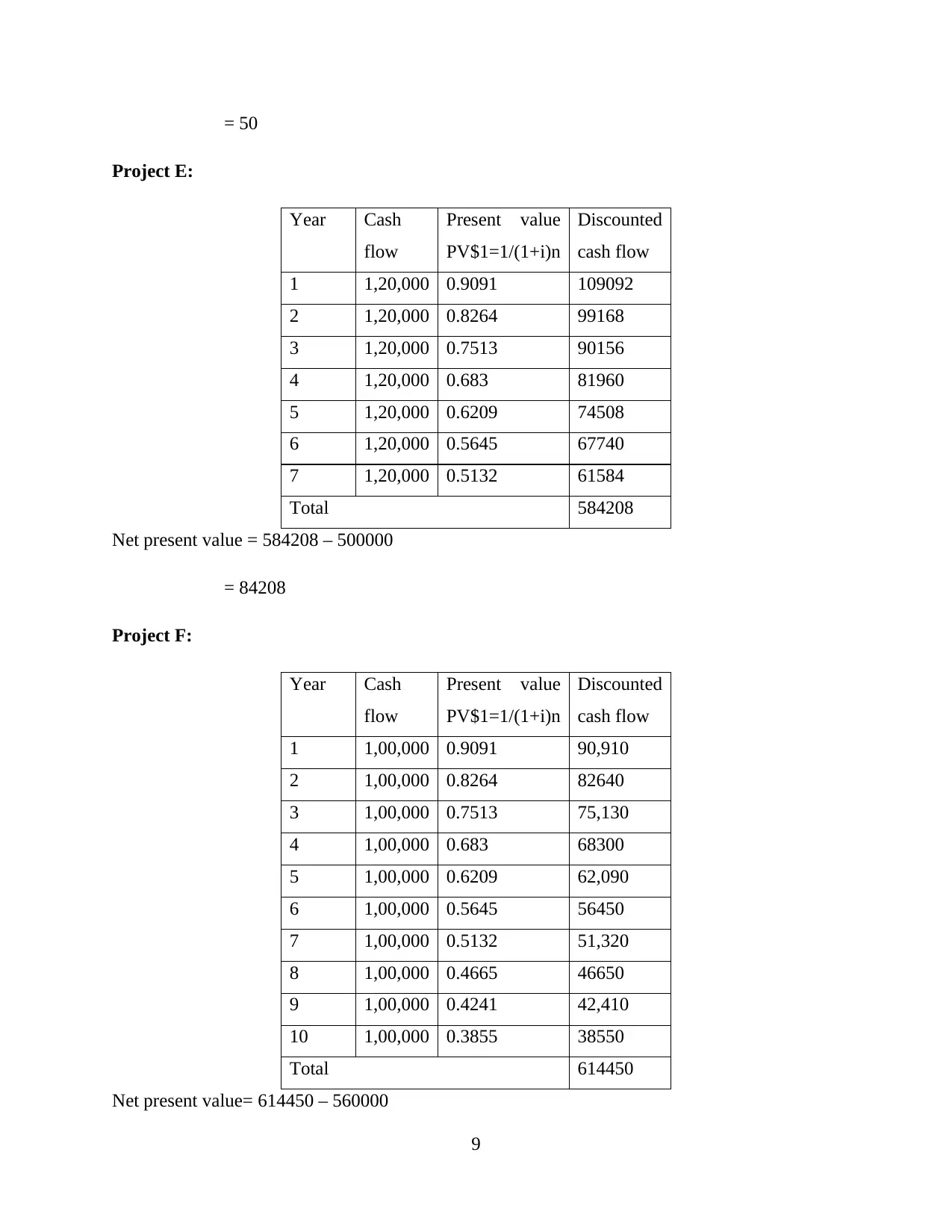
= 50
Project E:
Year Cash
flow
Present value
PV$1=1/(1+i)n
Discounted
cash flow
1 1,20,000 0.9091 109092
2 1,20,000 0.8264 99168
3 1,20,000 0.7513 90156
4 1,20,000 0.683 81960
5 1,20,000 0.6209 74508
6 1,20,000 0.5645 67740
7 1,20,000 0.5132 61584
Total 584208
Net present value = 584208 – 500000
= 84208
Project F:
Year Cash
flow
Present value
PV$1=1/(1+i)n
Discounted
cash flow
1 1,00,000 0.9091 90,910
2 1,00,000 0.8264 82640
3 1,00,000 0.7513 75,130
4 1,00,000 0.683 68300
5 1,00,000 0.6209 62,090
6 1,00,000 0.5645 56450
7 1,00,000 0.5132 51,320
8 1,00,000 0.4665 46650
9 1,00,000 0.4241 42,410
10 1,00,000 0.3855 38550
Total 614450
Net present value= 614450 – 560000
9
Project E:
Year Cash
flow
Present value
PV$1=1/(1+i)n
Discounted
cash flow
1 1,20,000 0.9091 109092
2 1,20,000 0.8264 99168
3 1,20,000 0.7513 90156
4 1,20,000 0.683 81960
5 1,20,000 0.6209 74508
6 1,20,000 0.5645 67740
7 1,20,000 0.5132 61584
Total 584208
Net present value = 584208 – 500000
= 84208
Project F:
Year Cash
flow
Present value
PV$1=1/(1+i)n
Discounted
cash flow
1 1,00,000 0.9091 90,910
2 1,00,000 0.8264 82640
3 1,00,000 0.7513 75,130
4 1,00,000 0.683 68300
5 1,00,000 0.6209 62,090
6 1,00,000 0.5645 56450
7 1,00,000 0.5132 51,320
8 1,00,000 0.4665 46650
9 1,00,000 0.4241 42,410
10 1,00,000 0.3855 38550
Total 614450
Net present value= 614450 – 560000
9
⊘ This is a preview!⊘
Do you want full access?
Subscribe today to unlock all pages.

Trusted by 1+ million students worldwide
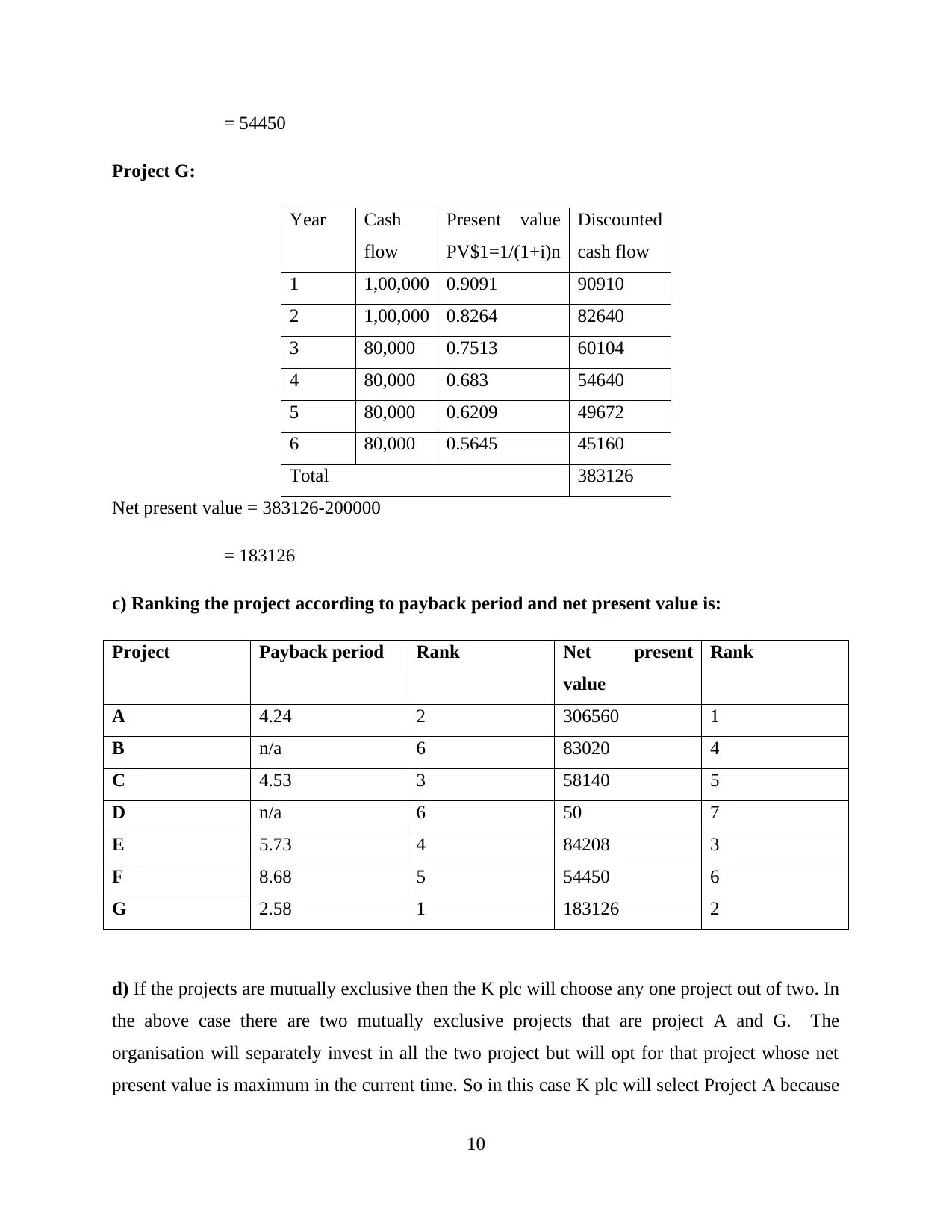
= 54450
Project G:
Year Cash
flow
Present value
PV$1=1/(1+i)n
Discounted
cash flow
1 1,00,000 0.9091 90910
2 1,00,000 0.8264 82640
3 80,000 0.7513 60104
4 80,000 0.683 54640
5 80,000 0.6209 49672
6 80,000 0.5645 45160
Total 383126
Net present value = 383126-200000
= 183126
c) Ranking the project according to payback period and net present value is:
Project Payback period Rank Net present
value
Rank
A 4.24 2 306560 1
B n/a 6 83020 4
C 4.53 3 58140 5
D n/a 6 50 7
E 5.73 4 84208 3
F 8.68 5 54450 6
G 2.58 1 183126 2
d) If the projects are mutually exclusive then the K plc will choose any one project out of two. In
the above case there are two mutually exclusive projects that are project A and G. The
organisation will separately invest in all the two project but will opt for that project whose net
present value is maximum in the current time. So in this case K plc will select Project A because
10
Project G:
Year Cash
flow
Present value
PV$1=1/(1+i)n
Discounted
cash flow
1 1,00,000 0.9091 90910
2 1,00,000 0.8264 82640
3 80,000 0.7513 60104
4 80,000 0.683 54640
5 80,000 0.6209 49672
6 80,000 0.5645 45160
Total 383126
Net present value = 383126-200000
= 183126
c) Ranking the project according to payback period and net present value is:
Project Payback period Rank Net present
value
Rank
A 4.24 2 306560 1
B n/a 6 83020 4
C 4.53 3 58140 5
D n/a 6 50 7
E 5.73 4 84208 3
F 8.68 5 54450 6
G 2.58 1 183126 2
d) If the projects are mutually exclusive then the K plc will choose any one project out of two. In
the above case there are two mutually exclusive projects that are project A and G. The
organisation will separately invest in all the two project but will opt for that project whose net
present value is maximum in the current time. So in this case K plc will select Project A because
10
Paraphrase This Document
Need a fresh take? Get an instant paraphrase of this document with our AI Paraphraser
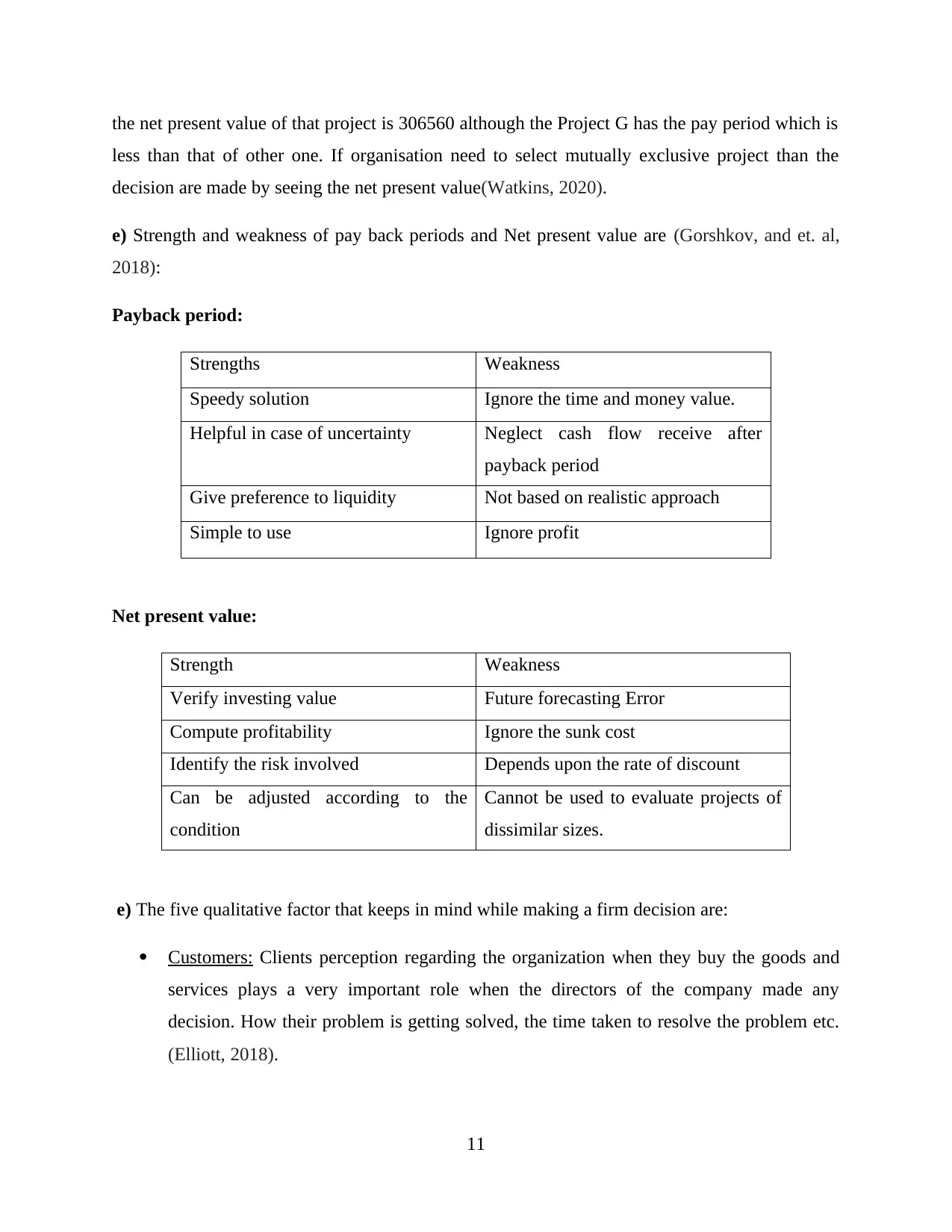
the net present value of that project is 306560 although the Project G has the pay period which is
less than that of other one. If organisation need to select mutually exclusive project than the
decision are made by seeing the net present value(Watkins, 2020).
e) Strength and weakness of pay back periods and Net present value are (Gorshkov, and et. al,
2018):
Payback period:
Strengths Weakness
Speedy solution Ignore the time and money value.
Helpful in case of uncertainty Neglect cash flow receive after
payback period
Give preference to liquidity Not based on realistic approach
Simple to use Ignore profit
Net present value:
Strength Weakness
Verify investing value Future forecasting Error
Compute profitability Ignore the sunk cost
Identify the risk involved Depends upon the rate of discount
Can be adjusted according to the
condition
Cannot be used to evaluate projects of
dissimilar sizes.
e) The five qualitative factor that keeps in mind while making a firm decision are:
Customers: Clients perception regarding the organization when they buy the goods and
services plays a very important role when the directors of the company made any
decision. How their problem is getting solved, the time taken to resolve the problem etc.
(Elliott, 2018).
11
less than that of other one. If organisation need to select mutually exclusive project than the
decision are made by seeing the net present value(Watkins, 2020).
e) Strength and weakness of pay back periods and Net present value are (Gorshkov, and et. al,
2018):
Payback period:
Strengths Weakness
Speedy solution Ignore the time and money value.
Helpful in case of uncertainty Neglect cash flow receive after
payback period
Give preference to liquidity Not based on realistic approach
Simple to use Ignore profit
Net present value:
Strength Weakness
Verify investing value Future forecasting Error
Compute profitability Ignore the sunk cost
Identify the risk involved Depends upon the rate of discount
Can be adjusted according to the
condition
Cannot be used to evaluate projects of
dissimilar sizes.
e) The five qualitative factor that keeps in mind while making a firm decision are:
Customers: Clients perception regarding the organization when they buy the goods and
services plays a very important role when the directors of the company made any
decision. How their problem is getting solved, the time taken to resolve the problem etc.
(Elliott, 2018).
11
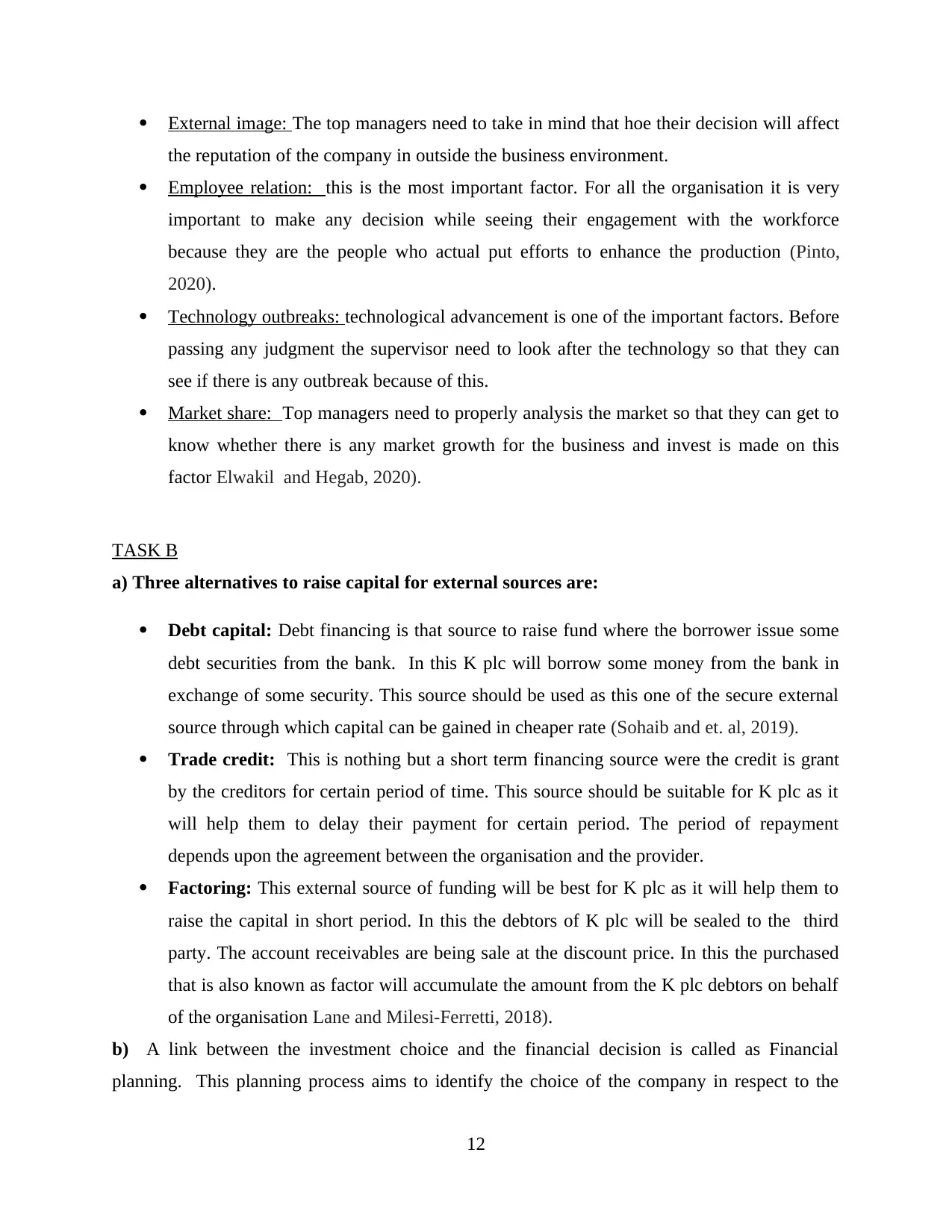
External image: The top managers need to take in mind that hoe their decision will affect
the reputation of the company in outside the business environment.
Employee relation: this is the most important factor. For all the organisation it is very
important to make any decision while seeing their engagement with the workforce
because they are the people who actual put efforts to enhance the production (Pinto,
2020).
Technology outbreaks: technological advancement is one of the important factors. Before
passing any judgment the supervisor need to look after the technology so that they can
see if there is any outbreak because of this.
Market share: Top managers need to properly analysis the market so that they can get to
know whether there is any market growth for the business and invest is made on this
factor Elwakil and Hegab, 2020).
TASK B
a) Three alternatives to raise capital for external sources are:
Debt capital: Debt financing is that source to raise fund where the borrower issue some
debt securities from the bank. In this K plc will borrow some money from the bank in
exchange of some security. This source should be used as this one of the secure external
source through which capital can be gained in cheaper rate (Sohaib and et. al, 2019).
Trade credit: This is nothing but a short term financing source were the credit is grant
by the creditors for certain period of time. This source should be suitable for K plc as it
will help them to delay their payment for certain period. The period of repayment
depends upon the agreement between the organisation and the provider.
Factoring: This external source of funding will be best for K plc as it will help them to
raise the capital in short period. In this the debtors of K plc will be sealed to the third
party. The account receivables are being sale at the discount price. In this the purchased
that is also known as factor will accumulate the amount from the K plc debtors on behalf
of the organisation Lane and Milesi-Ferretti, 2018).
b) A link between the investment choice and the financial decision is called as Financial
planning. This planning process aims to identify the choice of the company in respect to the
12
the reputation of the company in outside the business environment.
Employee relation: this is the most important factor. For all the organisation it is very
important to make any decision while seeing their engagement with the workforce
because they are the people who actual put efforts to enhance the production (Pinto,
2020).
Technology outbreaks: technological advancement is one of the important factors. Before
passing any judgment the supervisor need to look after the technology so that they can
see if there is any outbreak because of this.
Market share: Top managers need to properly analysis the market so that they can get to
know whether there is any market growth for the business and invest is made on this
factor Elwakil and Hegab, 2020).
TASK B
a) Three alternatives to raise capital for external sources are:
Debt capital: Debt financing is that source to raise fund where the borrower issue some
debt securities from the bank. In this K plc will borrow some money from the bank in
exchange of some security. This source should be used as this one of the secure external
source through which capital can be gained in cheaper rate (Sohaib and et. al, 2019).
Trade credit: This is nothing but a short term financing source were the credit is grant
by the creditors for certain period of time. This source should be suitable for K plc as it
will help them to delay their payment for certain period. The period of repayment
depends upon the agreement between the organisation and the provider.
Factoring: This external source of funding will be best for K plc as it will help them to
raise the capital in short period. In this the debtors of K plc will be sealed to the third
party. The account receivables are being sale at the discount price. In this the purchased
that is also known as factor will accumulate the amount from the K plc debtors on behalf
of the organisation Lane and Milesi-Ferretti, 2018).
b) A link between the investment choice and the financial decision is called as Financial
planning. This planning process aims to identify the choice of the company in respect to the
12
⊘ This is a preview!⊘
Do you want full access?
Subscribe today to unlock all pages.

Trusted by 1+ million students worldwide
1 out of 19
Related Documents
Your All-in-One AI-Powered Toolkit for Academic Success.
+13062052269
info@desklib.com
Available 24*7 on WhatsApp / Email
![[object Object]](/_next/static/media/star-bottom.7253800d.svg)
Unlock your academic potential
Copyright © 2020–2025 A2Z Services. All Rights Reserved. Developed and managed by ZUCOL.





